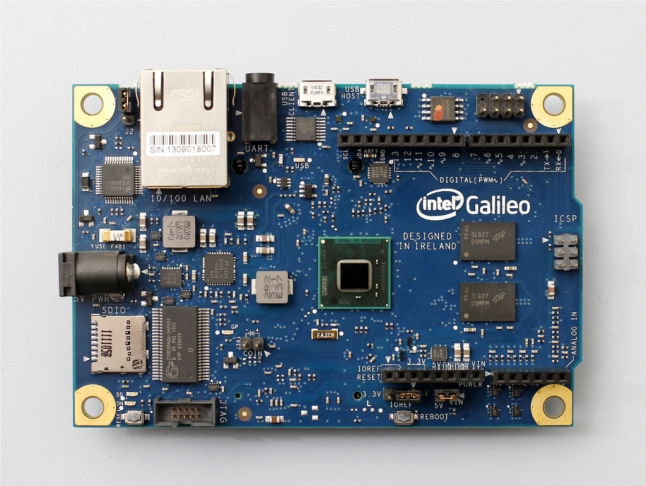Intel Galileo - Primeira Geração
- Publicado em Kits de desenvolvimento
Similar ao sistema embarcado Raspberry PI, o Intel Galileo é um sistema SoC compatível com Arduino, possibilitando a programação à nível de hardware por meio da IDE oficial do próprio Arduino. Nesta página, apresentamos a primeira geração da placa Galileo com processador SoC de 400MHz Quark, 512KB de memória SRAM, Ethernet, 6 entradas analógicas, porta UART e pinos compatíveis com o Arduino Uno R3. Não obstante a compatibilidade com o Arduino, trata-se na verdade de um computador de baixo custo baseado no Pentium com capacidade de execução do Linux, mas com um emulador Arduino.
Especificações Técnicas
Galileo is a microcontroller board based on the Intel® Quark SoC X1000 Application Processor, a 32-bit Intel Pentium-class system on a chip (datasheet). It’s the first board based on Intel® architecture designed to be hardware and software pin-compatible with Arduino shields designed for the Uno R3. Digital pins 0 to 13 (and the adjacent AREF and GND pins), Analog inputs 0 to 5, the power header, ICSP header, and the UART port pins (0 and 1), are all in the same locations as on the Arduino Uno R3. This is also known as the Arduino 1.0 pinout.
Galileo is designed to support shields that operate at either 3.3V or 5V. The core operating voltage of Galileo is 3.3V. However, a jumper on the board enables voltage translation to 5V at the I/O pins. This provides support for 5V Uno shields and is the default behavior. By switching the jumper position, the voltage translation can be disabled to provide 3.3V operation at the I/O pins.
Of course, the Galileo board is also software compatible with the Arduino Software Development Environment (IDE), which makes usability and introduction a snap. In addition to Arduino hardware and software compatibility, the Galileo board has several PC industry standard I/O ports and features to expand native usage and capabilities beyond the Arduino shield ecosystem. A full sized mini-PCI Express slot, 100Mb Ethernet port, Micro-SD slot, RS-232 serial port, USB Host port, USB Client port, and 8MByte NOR flash come standard on the board.
Fotos
Itens relacionados (por tag)
- Sensores de luminosidade TEMT6000 e BH1750
- Integrando o Arduino em sistemas de automação via MODBUS TCP
- Sintetizador DDS 200MHz Analog Devices AD9959 até 500 Msps de quatro canais
- Tempo de subida e descida do gerador de clock (pulsos) Si5351 150MHz
- Análise do Atenuador Programável RF Peregrine PE4306 4 GHz





